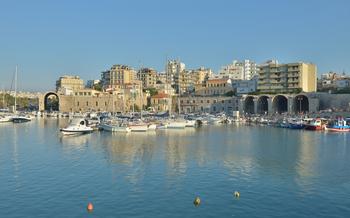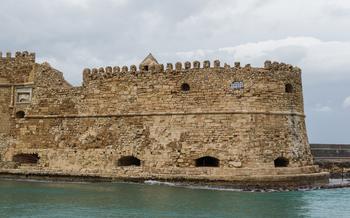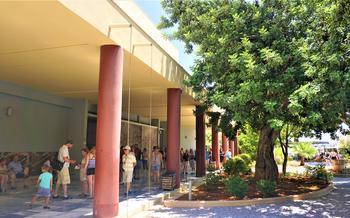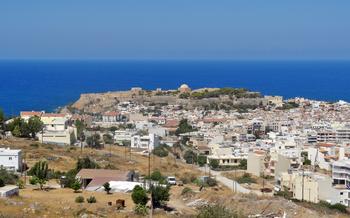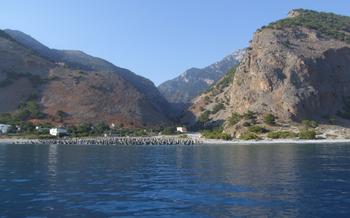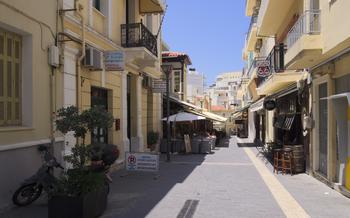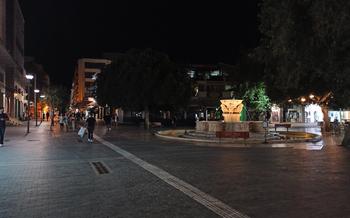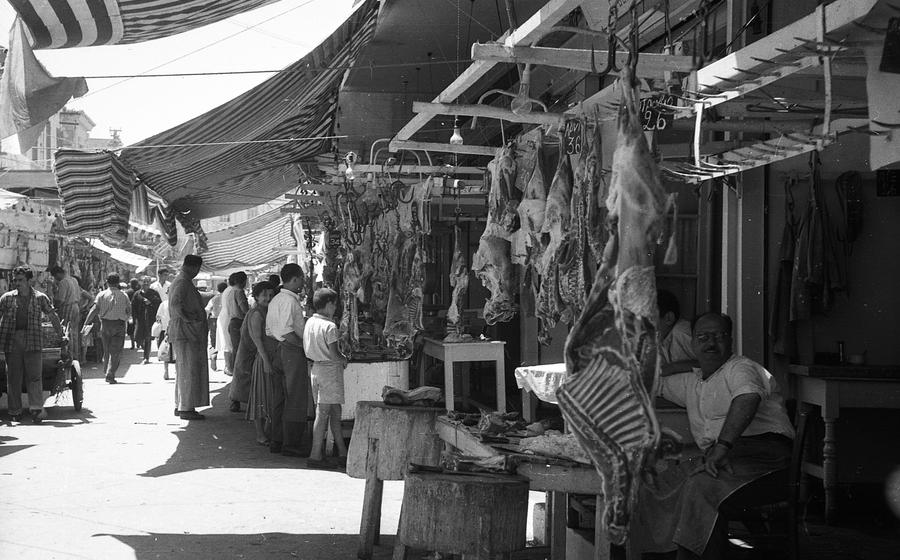
Heraklion Market
- Must-See Landmarks
- Culinary Delights
- Handmade Crafts
- Local Delicacies
- Market Etiquette
- Shopping Tips
- Historical Significance
- Photography and Videography
- Culinary Workshops
- Cultural Performances
- Festivals and Events
- Local Interactions
- Hidden Gems
- Insider Tip: Morning Market Stroll
Must-See Landmarks
Heraklion Market is not only a culinary paradise but also home to several historical and cultural landmarks that tell the story of Heraklion's rich past. Among the must-see attractions within the market area are:
-
The Historical Museum of Crete: Located in a 16th-century Venetian building, this museum houses an extensive collection of artifacts that trace the history of Crete from prehistoric times to the present day. Highlights include Minoan frescoes, Roman mosaics, and Byzantine icons.
-
The Venetian Walls: These impressive fortifications were built by the Venetians in the 16th century to protect the city from invaders. Today, visitors can walk along the top of the walls and enjoy stunning views of the city and the surrounding countryside.
-
The Morosini Fountain: This beautiful fountain was built in 1628 by the Venetian governor of Crete, Francesco Morosini. The fountain is decorated with intricate carvings and sculptures, and it is a popular spot for visitors to take photos.
Culinary Delights
Heraklion's market is a paradise for food lovers, offering an array of culinary delights that showcase the flavors and traditions of Crete. Indulge in the freshest catches of the day at the fish market, where gleaming fish and glistening shellfish beckon. Discover the liquid gold of Crete, the renowned olive oil, and learn about its health benefits and versatile culinary uses. Explore the vibrant colors and aromas of locally grown herbs and spices, essential ingredients in Cretan cuisine. Sample traditional delicacies such as dakos, a barley rusk topped with fresh tomatoes, feta cheese, and oregano, or satisfy your sweet tooth with bougatsa, a flaky pastry filled with sweet or savory fillings. Delight in loukoumades, bite-sized honey-drizzled doughnuts, a beloved Greek dessert. Immerse yourself in the culinary wonders of Heraklion's market, where every taste tells a story of the island's rich gastronomic heritage.
Handmade Crafts
In the heart of the Heraklion Market, skilled artisans showcase their exceptional craftsmanship through a variety of handmade goods. These treasures, crafted with love and precision, reflect the rich cultural heritage of Crete.
Leather Goods: Admire the intricate designs and impeccable quality of handmade leather goods, from supple bags and wallets to durable sandals. Each piece is a testament to the artisan's mastery of traditional techniques, ensuring both durability and style.
Pottery: Discover the vibrant colors and intricate patterns of handmade pottery, each piece unique and infused with the artist's creativity. From decorative plates and vases to functional cookware, these ceramics add a touch of Cretan charm to any home.
Jewelry: Immerse yourself in the sparkle of exquisite gold and silver jewelry, adorned with colorful gemstones and intricate designs. Whether it's a delicate necklace, a statement ring, or a pair of elegant earrings, these pieces are sure to capture your heart.
Local Delicacies
Heraklion Market is a haven for food enthusiasts, offering a tantalizing array of local delicacies that celebrate the rich culinary traditions of Crete. Among these culinary delights, three stand out as must-try experiences.
Dakos: This traditional Cretan dish is a symphony of flavors and textures. Barley rusks, a staple of the Cretan diet, form the base, topped with a refreshing combination of ripe tomatoes, creamy feta cheese, and aromatic oregano. The result is a delightful burst of flavors that encapsulates the essence of Cretan cuisine.
Bougatsa: Indulge in the flaky layers of this beloved Greek pastry, filled with either sweet or savory fillings. The sweet version, a popular breakfast treat, bursts with creamy custard or sweet cheese, while the savory version tantalizes with minced meat or vegetables. Bougatsa is a culinary delight that will satisfy any sweet or savory craving.
Loukoumades: These bite-sized honey-drizzled doughnuts are a symbol of Greek indulgence. Crispy on the outside and fluffy on the inside, loukoumades are often filled with decadent chocolate or custard. Drizzled with honey syrup and sprinkled with cinnamon, these delectable treats are a feast for the senses.
Market Etiquette
Navigating the bustling streets of Heraklion's market, it is essential to be mindful of local customs and market etiquette. Bargaining is a common practice, and vendors are open to negotiating prices. However, it's important to approach bargaining with respect and politeness. Start with a fair offer and be prepared to compromise.
While English may be spoken in some areas of the market, it is not universally understood by all vendors. Learning a few basic Greek phrases, such as "kalimera" for good morning and "efharisto" for thank you, can go a long way in showing respect and facilitating communication.
Remember that the market is a place of work for many vendors, so be mindful of their time and avoid prolonged haggling. Be patient and understanding, and remember that the goal is to create a positive and mutually beneficial interaction.
Shopping Tips
Navigating the bustling Heraklion Market requires a strategic approach to ensure a successful shopping experience. Here are some valuable tips to enhance your visit:
-
Timing is Key: Plan your market visit for the early hours of the morning to take advantage of the freshest produce and seafood. Vendors typically set up their stalls before sunrise, creating a vibrant atmosphere as the market comes to life. Early mornings also offer cooler temperatures, making it more pleasant to browse and shop.
-
Embrace Cash: While some vendors may accept credit cards or digital payments, cash remains the preferred mode of transaction in the Heraklion Market. Carrying sufficient cash will ensure a smooth and hassle-free shopping experience, allowing you to make purchases without any technological glitches or connectivity issues.
-
Souvenirs with a Purpose: When selecting souvenirs, opt for items that reflect the unique culture and craftsmanship of Crete. Look for handmade leather goods, intricate pottery, or exquisite jewelry that showcases the skills and artistry of local artisans. These souvenirs will serve as lasting mementos of your time in Heraklion and support the local economy.
Historical Significance
Heraklion Market is a testament to the rich history and cultural influences that have shaped Heraklion. The market's origins can be traced back to the Venetian period when the city served as a major trading hub. During this time, the market became a bustling center for commerce, with merchants from across the Mediterranean bringing their goods to trade.
The Ottoman conquest of Crete in the 17th century brought new influences to the market. The Ottomans introduced new products and customs, and the market became a melting pot of cultures. This vibrant blend of Venetian and Ottoman influences can still be seen in the market's architecture, its diverse range of goods, and the lively atmosphere that permeates the streets.
Archaeological excavations in the market area have uncovered remnants of ancient civilizations that predate the Venetian and Ottoman periods. These discoveries provide a glimpse into the rich history of the region and the role that Heraklion has played as a cultural and commercial center throughout the centuries.
Local stories and legends add to the mystique of Heraklion Market. These tales, passed down from generation to generation, bring the market's past to life and offer a glimpse into the lives of the people who have worked and traded within its walls for centuries.
Photography and Videography
Heraklion Market is a visual feast, a photographer's paradise. The vibrant colors of the fresh produce, the intricate patterns of the handmade crafts, and the lively interactions between vendors and shoppers create a tapestry of sights that begs to be captured.
To truly capture the essence of the market, go beyond snapshots and embrace the art of storytelling through photography and videography. Learn to see the market with a discerning eye, noticing the details that often go unnoticed. Play with angles and perspectives, using the narrow alleys and bustling crowds to create dynamic compositions. Experiment with lighting, using the golden hues of sunrise or the soft glow of dusk to create atmospheric images.
Respect the privacy of the people you photograph or film. Ask permission before taking their picture, and be mindful of their comfort level. Remember that the market is a place of business, and vendors may not always appreciate having their work interrupted.
If you're serious about capturing the essence of Heraklion Market, consider taking a photography or videography workshop. These workshops can teach you the technical skills you need to create stunning images, as well as provide you with insights into the culture and history of the market.
Culinary Workshops
Heraklion's market is not just a place to buy and sell goods, but also a place to learn and experience the culinary traditions of Crete. Visitors can participate in cooking classes led by local chefs, who use fresh ingredients from the market to teach traditional Cretan dishes. These classes offer a hands-on opportunity to learn about the flavors and techniques of Cretan cuisine.
In addition to cooking classes, visitors can also participate in cheese-making workshops, where they can learn the art of making artisanal cheeses. Crete is known for its delicious cheeses, and these workshops provide a unique opportunity to learn how to make them from scratch. Participants will learn about the different types of milk, the renneting process, and the aging process. They will also get to taste the finished product, which they can take home with them as a souvenir.
For those who want to learn more about olive oil, there are olive oil tasting workshops available. These workshops offer participants the chance to taste different varieties of olive oil and learn about their flavor profiles. Visitors will also learn about the different stages of olive oil production, from harvesting the olives to pressing them to extract the oil.
Cultural Performances
Heraklion Market is not just a place of commerce; it's also a stage for cultural expression. Traditional Cretan music fills the air, with musicians playing lyres, lutes, and violins, accompanied by the rhythmic clapping and dancing of locals. The infectious melodies and lively performances create an irresistible atmosphere that draws visitors into the heart of Cretan culture.
Street performers add to the vibrant ambiance, showcasing their talents through music, juggling, acrobatics, and storytelling. These talented individuals bring smiles to the faces of passersby and create lasting memories for visitors.
In the evenings, the market transforms into a storytelling haven. Local storytellers gather to share tales and legends that have been passed down through generations, captivating listeners with their vivid narratives and colorful characters. These storytelling sessions offer a unique glimpse into the rich cultural heritage of Crete and provide a deeper understanding of the island's traditions and beliefs.
Festivals and Events
Heraklion Market comes alive during annual festivals, religious celebrations, and seasonal events that showcase the vibrant spirit of the city. Immerse yourself in the festivities of the annual Market Festival, where the streets buzz with music, dance, and colorful displays of local products. Witness the fervor of religious processions and ceremonies that take place within the market, adding a spiritual dimension to the shopping experience. Throughout the year, seasonal events celebrate the changing seasons, highlighting local produce and traditions. From harvest festivals showcasing the bounty of the Cretan land to Christmas markets filled with festive cheer, these events offer a glimpse into the rich cultural heritage of Heraklion.
Local Interactions
Heraklion Market is not just a place of commerce; it's also a hub of social interaction and cultural exchange. Engaging with locals is an integral part of the market experience. Strike up conversations with vendors to learn about their products, their families, and their stories. They'll be delighted to share their knowledge of local ingredients, cooking techniques, and traditional recipes.
Join guided market tours led by locals who can provide insights into the market's history, culture, and hidden gems. These tours offer a deeper understanding of the market's significance and the lives of the people who work and shop there.
Embrace opportunities for language and cultural exchange. Even if you don't speak much Greek, a few friendly gestures and a smile can go a long way. Locals will appreciate your efforts to connect with them and may even teach you a few Greek phrases.
Respect is paramount in any interaction. Be mindful of local customs and traditions, and avoid offending anyone unintentionally. Dress modestly, refrain from loud or boisterous behavior, and always ask permission before taking photos or videos of people.
By engaging with locals, you'll not only discover the market's hidden treasures but also gain a deeper appreciation for the warmth and hospitality of the Cretan people.
Hidden Gems
As you wander through the labyrinthine alleys of the Heraklion Market, keep an eye out for hidden gems tucked away from the main thoroughfares. These off-the-beaten-path shops often house unique finds and local treasures that you won't find anywhere else. From quaint boutiques selling handmade crafts to family-run tavernas serving authentic Cretan cuisine, these hidden gems offer a glimpse into the true heart of the market.
Don't be afraid to venture down narrow side streets and explore the hidden corners of the market. You might stumble upon a charming café nestled between two buildings, offering a tranquil oasis amidst the bustling crowds. Or you might discover a small shop selling traditional musical instruments, where you can learn about the rich musical heritage of Crete.
For a unique perspective of the market, seek out rooftop terraces within the market's buildings. These hidden vantage points offer panoramic views of the surrounding rooftops, the Venetian walls, and the distant mountains. Take a moment to soak in the atmosphere and appreciate the beauty of the market from a different angle.
Finally, don't hesitate to ask friendly vendors for recommendations on hidden culinary gems and traditional recipes. They may share insider tips on where to find the best souvlaki in town or direct you to a local bakery that makes the most delicious pastries. Embrace the opportunity to engage with the locals and learn about their favorite market secrets.
Insider Tip: Morning Market Stroll
To truly immerse yourself in the authentic charm of Heraklion Market, consider visiting at sunrise. As the city awakens, you'll witness a magical transformation as vendors set up their stalls and the air fills with the intoxicating aromas of fresh produce, herbs, and spices. The early morning light casts a golden glow on the market's narrow streets, creating a picturesque scene that captures the essence of traditional Greek market life. With fewer crowds, you'll have the opportunity to engage in leisurely conversations with vendors, barter for unique finds, and savor the tranquility of the market before the hustle and bustle of the day begins. Embracing this insider tip will offer you a truly unforgettable experience in Heraklion Market, allowing you to connect with the local culture and create lasting memories.
